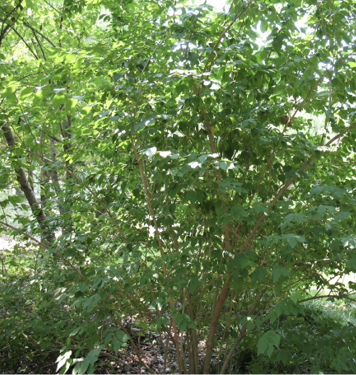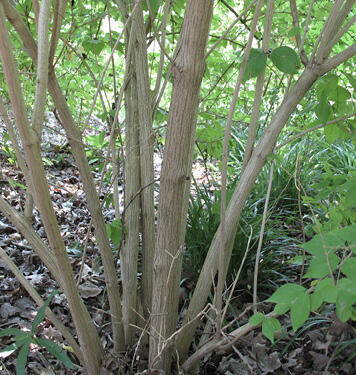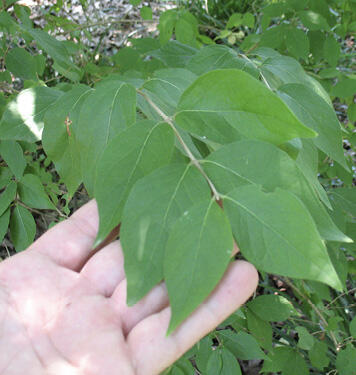P3192
Amur Honeysuckle
.png)



Amur honeysuckle [Lonicera maackii (Rupr.) Herder] is a deciduous shrub native to parts of Asia from northeast China to Korea. It was introduced into the U.S. in the mid-1800s but escaped cultivation. It has been used as an ornamental. Amur honeysuckle is not regulated in the Midsouth region. Of the Midsouth states, it is most problematic in Tennessee, but it can also be found in other southern states. Amur honeysuckle is tolerant of a wide range of conditions, and it can completely dominate the understory of deciduous forests.
Description
Vegetative Growth
Amur honeysuckle is a large shrub reaching around 12 feet tall and 6 feet wide (Figure 1). Bark is generally tan and relatively smooth (Figure 2). Leaf arrangement is opposite with simple leaves 2–3 inches long. Leaves are ½–1½ inches wide, oval to broadly elliptical, and covered with hairs (Figure 3).
Flowering
Flowers are produced from April to early June, are white fading to cream, are an inch long, and are borne in axillary pairs. The honeysuckle’s fruit are red berries, which vary in size but are generally around ¼ inch in diameter; these berries are produced in clusters with one or more seeds. Fruit ripen in October but may persist until February or March.
Dispersal
Birds primarily disperse the small, red berries of Amur honeysuckle.
Habitat
Amur honeysuckle is a problem in fence rows, abandoned pastures, fields, roadsides, roadside margins, forests, and open woodlands. It can tolerate a wide range of light and moisture conditions, and it forms dense thickets in forests, replacing the surrounding native vegetation. Although these thickets may provide habitat and some food for certain wildlife, they are a difficult barrier for human activity. Seeds can be spread by birds over some distance to new sites.
Distribution
Amur honeysuckle is widespread in the eastern U.S., but it has apparently not escaped in the western plains or Rocky Mountains. In the right habitat, it can be very common in certain eastern states, particularly in deciduous forests of the Northeast. It is considered hardy in the U.S. from zones 3 to 8. It is still sold occasionally for landscapes, although it is regulated in some states.
Amur honeysuckle is widespread in Tennessee, but it is mostly restricted to a few northern counties in Alabama and Mississippi and the eastern counties of Arkansas. Since it continues to spread, its full range of adaptation is not known.
Control Methods
Chemical
See Table 1 for recommended chemical treatments. These products can be applied in a variety of methods that include foliar, frill, basal bark, cut stump, or soil applications. Frill (also known as hack-and-squirt) requires a hatchet, machete, or ax to create an opening in the bark every 2 inches around the trunk; the herbicide is applied in these openings. Basal bark applications are made by spraying the lower 18–24 inches of the entire plant trunk with a bark-penetrating adjuvant. These treatments are most effective on trunks less than 4 inches in diameter and when treated just before bud break. Cut stump applications are made after the tree has been felled; the woody tissue just inside the bark of the remaining stump is treated to prevent resprouting. All foliar and basal bark applications also require a nonionic surfactant at 32–64 ounces per 100 gallons of spray solution. Imazapyr and picloram are absorbed by tree roots, so applications made within two times the dripline of desirable trees may cause injury or death.
Mechanical
Since Amur honeysuckle is shallow-rooted, mechanical removal with a bulldozer is feasible. Care should be taken to remove the entire root mass to ensure no resprouting. Mowing will cause multiple stems to sprout.
More Information
The genus Lonicera belongs to the honeysuckle (Caprifoliaceae) family. About 180 species of Lonicera worldwide are distributed from northern temperate regions to Mexico and the Philippines. Some species of Lonicera are native to the midsouth United States. Native Lonicera have flowers that range in color from yellow to red while most nonnative honeysuckles produce white to yellow flowers. Growth forms are also variable and range from vines like Japanese honeysuckle (Lonicera japonica Thunb.) to shrubs. Species may be deciduous or evergreen. Amur honeysuckle is sometimes confused with other shrub honeysuckles, like Morrow’s honeysuckle (Lonicera morrowii Gray), which has flower stalks much longer than the leaf stems. Tartarian honeysuckle (Lonicera tartarica L.) and winter honeysuckle (Lonicera fragrantissima Lindl. & Paxton) are less hairy than Amur honeysuckle.
|
Herbicide |
Formulation |
Method |
Rate |
|
Glyphosate |
3 lb ae/gal |
Foliar |
2% solution |
|
Glyphosate |
3 lb ae/gal |
Cut stump or frill |
Undiluted |
|
Imazapyr |
2 lb ae/gal |
Foliar or soil |
32–96 oz/A or 2% |
|
Imazapyr |
2 lb ae/gal |
Frill or cut stump |
64 oz + 32 oz water |
|
Picloram + 2, 4-D |
3% + 11.2% |
Frill or cut stump |
Undiluted |
|
Triclopyr |
4 lb ae/gal |
Basal |
20% solution + bark penetrator |
|
Triclopyr |
4 lb ae/gal |
Frill |
20% solution |
|
Triclopyr |
4 lb ae/gal |
Cut stump |
Undiluted |
References
Dirr, M. A. (1998). Manual of woody landscape plants: Their identification, ornamental characteristics, culture, propagation, and uses. 5th ed. Stipes Publishing LLC.
Miller, J. H. (2003). Nonnative invasive plants of southern forests: A field guide for identification and control. Southern Research Station Publications.
USDA, NRCS. (2007). The PLANTS Database.
Publication 3192 (POD-04-24)
By John D. Byrd Jr., PhD, Extension/Research Professor, Plant and Soil Sciences; Victor Maddox, PhD, Senior Research Associate, Plant and Soil Sciences; and Randy Westbrooks, PhD, former Invasive Species Specialist, U.S. Geological Survey.
The Mississippi State University Extension Service is working to ensure all web content is accessible to all users. If you need assistance accessing any of our content, please email the webteam or call 662-325-2262.
